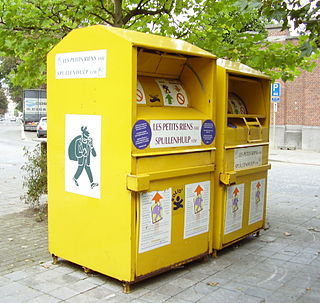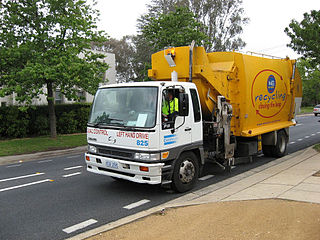
Recycling is the process of converting waste materials into new materials and objects. The recovery of energy from waste materials is often included in this concept. The recyclability of a material depends on its ability to reacquire the properties it had in its original state. It is an alternative to "conventional" waste disposal that can save material and help lower greenhouse gas emissions. It can also prevent the waste of potentially useful materials and reduce the consumption of fresh raw materials, reducing energy use, air pollution and water pollution.

Post-consumer waste is a waste type produced by the end consumer of a material stream; that is, where the waste-producing use did not involve the production of another product.

Although PET is used in several applications,, as of 2022 only bottles are collected at a substantial scale. The main motivations have been either cost reduction or recycle content of retail goods. An increasing amount is recycled back into bottles, the rest goes into fibres, film, thermoformed packaging and strapping. After sorting, cleaning and grinding, 'bottle flake' is obtained, which is then processed by either:

The recycling of paper is the process by which waste paper is turned into new paper products. It has a number of important benefits: It saves waste paper from occupying homes of people and producing methane as it breaks down. Because paper fibre contains carbon, recycling keeps the carbon locked up for longer and out of the atmosphere. Around two-thirds of all paper products in the US are now recovered and recycled, although it does not all become new paper. After repeated processing the fibres become too short for the production of new paper, which is why virgin fibre is frequently added to the pulp recipe.

Glass recycling is the processing of waste glass into usable products. Glass that is crushed or imploded and ready to be remelted is called cullet. There are two types of cullet: internal and external. Internal cullet is composed of defective products detected and rejected by a quality control process during the industrial process of glass manufacturing, transition phases of product changes and production offcuts. External cullet is waste glass that has been collected or reprocessed with the purpose of recycling. External cullet is classified as waste. The word "cullet", when used in the context of end-of-waste, will always refer to external cullet.

Reuse is the action or practice of using an item, whether for its original purpose or to fulfill a different function. It should be distinguished from recycling, which is the breaking down of used items to make raw materials for the manufacture of new products. Reuse – by taking, but not reprocessing, previously used items – helps save time, money, energy and resources. In broader economic terms, it can make quality products available to people and organizations with limited means, while generating jobs and business activity that contribute to the economy.

Nike Grind is a collection of recycled materials developed by Nike that is composed of pre-consumer manufacturing scraps, recycled post-consumer shoes from the Reuse-A-Shoe program, and unsellable footwear. The purpose of Nike Grind is to eliminate waste and close the loop on Nike's product lifecycle.
Fast fashion is a term used to describe the clothing industry's business model of replicating recent catwalk trends and high-fashion designs, mass-producing them at a low cost, and bringing them to retail stores quickly, while demand is at its highest. The term fast fashion is also used generically to describe the products of the fast fashion business model.

Textile recycling is the process of recovering fiber, yarn, or fabric and reprocessing the material into new, useful products. Textile waste is split into pre-consumer and post-consumer waste and is sorted into five different categories derived from a pyramid model. Textiles can be either reused or mechanically/chemically recycled.

Upcycling, also known as creative reuse, is the process of transforming by-products, waste materials, useless, or unwanted products into new materials or products perceived to be of greater quality, such as artistic value or environmental value.

Sustainable fashion is a term describing products, processes, activities, and actors aiming to achieve a carbon-neutral fashion industry, built on equality, social justice, animal welfare, and ecological integrity. Sustainable fashion concerns more than addressing fashion textiles or products. It addresses the entire process in which clothing is produced, consumed and disposed; who, what, how, when, where and the expected useful life of the product before entering landfill. The sustainable movement looks to combat the large carbon footprint that fast fashion has created by reducing the environmental impact of fashion such as air pollution, water pollution and overall climate change.
Recycling can be carried out on various raw materials. Recycling is an important part of creating more sustainable economies, reducing the cost and environmental impact of raw materials. Not all materials are easily recycled, and processing recyclable into the correct waste stream requires considerable energy. Some particular manufactured goods are not easily separated, unless specially process therefore have unique product-based recycling processes.
Products made from a variety of materials can be recycled using a number of processes.

Mobile phone recycling describes the waste management of mobile phones, to retrieve materials used in their manufacture. Rapid technology change, low initial cost, and planned obsolescence have resulted in a fast-growing surplus, which contributes to the increasing amount of electronic waste around the globe.
Zero-waste fashion refers to items of clothing that generate little or no textile waste in their production. It can be considered to be a part of the broader Sustainable fashion movement. Zero-waste fashion can be divided into two general approaches. Pre-consumer zero-waste fashion eliminates waste during manufacture. Post-consumer zero-waste fashion generates clothing from post-consumer garments such as second-hand clothing, eliminating waste at what would normally be the end of the product use life of a garment. Zero-waste fashion is not a new concept - early examples of zero-waste or near zero-waste garments include Kimono, Sari, Chiton and many other traditional folk costumes.

Cotton recycling is the process of converting cotton fabric into fibers that can be reused into other textile products.
Gypsum recycling is the process of turning gypsum waste into recycled gypsum, thereby generating a raw material that can replace virgin gypsum raw materials in the manufacturing of new products.

Food waste recycling is a process to convert food waste into useful materials and products for achieving sustainability of the environment. Food waste is defined as all parts of food, inedible and edible, created before, during, and after food processing, production, and consumption. Greenhouse gases, especially methane can be reduced by food waste recycling. Food waste recycling can also alleviate the saturation of landfill sites in Hong Kong.

Recycling in Australia is a widespread, but not a comprehensive part of waste management in Australia. Recycling occurs through commingled kerbside recycling collections, drop-off programs, and various other schemes. Collection and management of household recycling typically falls to local councils, with private contractors collecting commercial and industrial recycling. In addition to local councils, legislation and overarching policies are implemented and managed by the state and federal governments.

Recycled wool, rag wool or shoddy is any woollen textile or yarn made by shredding existing fabric and re-spinning the resulting fibres. Textile recycling is an important mechanism for reducing the need for raw wool in manufacturing.














